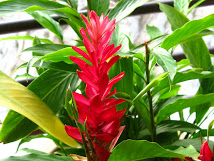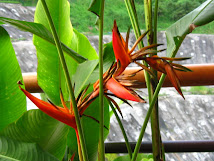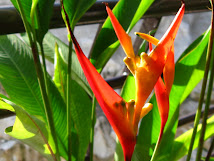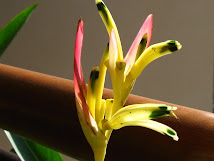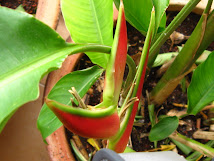Welcome to Heliconias... Heliconias... Heliconias
This blog is all about growing Heliconias, an exotic plant not native to Malaysia. All pictures shown are digital photos of the actual species in my garden such as Rostrata, Dwarf Jamaican, Latispatha and several psittacorums such as Andromeda, Lady Di, Fuschia, Strawberry & Cream and hybrids such as Golden Torch and Alan Carle.
Heliconia are close relatives of gingers, bananas, birds-of-paradise and traveler’s palms. There are more than 200 (350 including cultivars) documented species of the single genus, with the bulk of them originating from Central and South America such as Guyana, Costa Rica, Berlize, Ecuador, Peru and Brazil. You may be interested to note that about 6 species have evolved separately in the South Pacific and Indonesia, and typically have green inflorescence.The name "heliconia" actually comes from Greek mythology after the great Mount Helicon, the abode of the muses of the arts and sciences.
The beauty of the heliconia lies in the brightly coloured bracts that are mistakenly called the flowers. The actual flower is the tiny little flowers that emerge from the large showy bracts. Each stem can only flower once, after which the entire stem deteriorates, drives up and collapses. As such, it is recommended to cut at the base of 'flowered-out' stems.
BTW, this blog has been read by visitors from Australia, Brazil, Chile, Colombia, France, India, Japan, Malaysia, Philippines, Puerto Rico, Mexico, Netherlands Antilles, Netherland, Singapore, Spain, Thailand, Trinidad & Tobago, United Kingdom & United States of America :-)
16th Sept 2009 : 17:30
Heliconia are close relatives of gingers, bananas, birds-of-paradise and traveler’s palms. There are more than 200 (350 including cultivars) documented species of the single genus, with the bulk of them originating from Central and South America such as Guyana, Costa Rica, Berlize, Ecuador, Peru and Brazil. You may be interested to note that about 6 species have evolved separately in the South Pacific and Indonesia, and typically have green inflorescence.The name "heliconia" actually comes from Greek mythology after the great Mount Helicon, the abode of the muses of the arts and sciences.
The beauty of the heliconia lies in the brightly coloured bracts that are mistakenly called the flowers. The actual flower is the tiny little flowers that emerge from the large showy bracts. Each stem can only flower once, after which the entire stem deteriorates, drives up and collapses. As such, it is recommended to cut at the base of 'flowered-out' stems.
BTW, this blog has been read by visitors from Australia, Brazil, Chile, Colombia, France, India, Japan, Malaysia, Philippines, Puerto Rico, Mexico, Netherlands Antilles, Netherland, Singapore, Spain, Thailand, Trinidad & Tobago, United Kingdom & United States of America :-)
16th Sept 2009 : 17:30
Showing posts with label Inflorescence. Show all posts
Showing posts with label Inflorescence. Show all posts
Monday, October 27, 2008
Sunday, October 26, 2008
Anatomy of Inflorescence

The beauty of the heliconia lies in the brightly coloured bracts that are mistakenly called the flowers.
The actual flower is the tiny little flowers that emerge from the large showy bracts. The flower group (called an "inflorescence") is almost always at the end of long, leafy shoots.The stem is either erect or drooping , with respect to the leafy shoot from which it emerges. The inflorescence is made up of the peduncle and modified leaf-like structures known as bracts.
The rachis connects adjacent bracts. Within each bract there is a coil of inconspicuous flowers.
The fruits also develop within the bracts. The bracts are often filled with water and house a distinctive aquatic micro-ecosystem.
Monday, October 20, 2008
cv Fuschia, Heliconia Psittacorum
 Blooming
BloomingIn Malaysia, throughout the year but in non-tropical zones April to November.
Height
4- 6 Feet
Habitat
Full sun - 40 % of shade
Distribution
Uncertain [Hawaii]
Inflorescence
Bracts
4 - 5 bracts.
Fuschia (reddish-purple) with dusky area proximally
Rachis
Fuschia beneath basal bract to pale white-green on upper bract
Sepals
Light yellow with distal dark green band distally & whitish tip.
Ovary
Dark green on distal 5th & light-green proximally.
Pedicel
White
Vegetation
Musoid, reddish stripe along lower mid-rib on some

Labels:
Blooming,
bracts,
Fuschia,
Heliconia,
Inflorescence,
Ovary,
peduncle,
psittacorium,
rachis,
Sepals,
Vegetation
Sunday, October 19, 2008
cv Alan Carle, Heliconia aff. psittacorum x spathocircinata Aristeguieta

Just acquired a new specie. Looks like a Golden Torch with 5 red bracts.
On Page 153, of the Helconia An Indentification Guide, there is a strikingly similar looking Heliconia psittacorum x spathocircinata Aristeguieta cv Alan Carle. The dufference being the colur of the bracts, sepals being yellowish rather than reddist as in my specie.
Height
6-7 ft (3-5 ft for cv Alan Carle)
Inflorenscence
Bracts
5-6 bracts with red keel and cheek. (3-6; reddish on most of cheek & keel shading to yellowish on proximal cheek & along lip for cv Alan Carle)

Rachis
Reddish. (Greenish to yellow for cv Alan Carle)
Sepals
Dark greenish on Distal half , orangish on proximal part (Dark green on distal third with light tip, yellow on proximal part for cv Alan Carle)

Ovary
Orange proximal to yellowish distally. (yellow cv Alan Carle)
Pedicel
Orangish (cream or yellowish cv Alan Carle)
Peduncle
Greenish proximaly to reddish distally.

Vegetation
Musoid (like Banana Leaves)

Other Names
Labelled as Golden Opal in Costa Rica.
Labels:
Alan Carle,
Golden Opal,
Heliconia,
Hyrid,
Inflorescence,
Ovary,
peduncle,
psittacorium,
rachis,
Sepals,
Spathocircinata,
Vegetation
Sunday, October 12, 2008
cv Strawberries & Cream, Heliconia psittacorum L.f .

Did you notice the 2 fruits which are drupes (a hard seed surrounded by fleshy pulp) in the first picture ?
Blooming
All year
Height
3 - 5 Feet
Habitat
Full sun to 30 % of shade
Distribution
Uncertain [Hawaii]
Inflorescence
Bracts
3-5 bracts.
Strawberry red-pink distally & cream proximally. Basal bract mostly red-pink and a thin distal green keel.
Rachis
Cream with green tint
Sepals
Pale yellow with distal dark green bank and white tip. Orange with distal metallic black or green band.
Ovary
Pale yellow with green spot on distal corner
Pedicel
Cream with green tint.
Vegetation
Musoid


Labels:
Blooming,
bracts,
Heliconia,
Inflorescence,
Ovary,
peduncle,
psittacorium,
rachis,
Sepals,
Strawberry and Cream,
Vegetation
cv Andromeda, Heliconia psittacorum L.f .
 16th November 2008
16th November 2008 9th November 2008
9th November 2008 8th November 2008
8th November 2008 7th November 2008
7th November 2008 18th October 2008
18th October 2008 18th October 2008
18th October 2008Blooming
All year.
Height
1.5 - 9 Feet
Habitat
Full sun to 50 % of shade
Distribution
Guyana [now widely cultivated]
Inflorescence
Bracts
3-5 bracts.
Somewhat variable outer surface orange to red. Sometimes with green tint on keel. Inner surface red shading to orange proximally.
Rachis
Orange, Orange with red infusion or green.
Sepals
Orange with distal metallic black or green band & ornage tip.
Ovary
Dark orange distally & light orange or orange below.
Pedicel
Orange
Vegetation
Musoid
Labels:
Andromeda,
Blooming,
bracts,
Heliconia,
Inflorescence,
Ovary,
peduncle,
psittacorium,
rachis,
Sepals,
Vegetation
cv Las Cruces aka Eden Pink, Heliconia Stricta Huber




Blooming
In Malaysia, throughout the year but in non-tropical zones December to Septempter.
Height
3 - 5 Feet
Habitat
20 to 60 % of shade
Distribution
Uncertain [Florida & Costa Rica]
Inflorescence
Bracts
4-6 bracts.
Mostly red with narrow green & yellow lines along lip and a green keel on basal bract.
Rachis
Red
Sepals
Green distally with white tio & white below.
Ovary
White
Pedicel
White
Vegetation
Musoid, upper & lower mid-rib with red to maroon stripes, margins slighly undulated.
Labels:
Blooming,
bracts,
Heliconia,
Inflorescence,
Las Cruces,
Ovary,
peduncle,
rachis,
Sepals,
Stricta Huber,
Vegetation
cv Fire Flash, Heliconia densiflora verlot
 16th November 2008
16th November 2008 11th November 2008
11th November 2008 19th October 2008
19th October 2008 18th October 2008
18th October 2008 18th October 2008
18th October 2008A cluster of inflorescences...
Blooming
All year.
Height
1.5 to Feet
Habitat
Full sun - 40% of shade
Distribution
Uncertain [Florida, Hawaii, Australia & Costa Rica]
 18th October 2008
18th October 2008Inflorescence
Bracts
4-5 bracts.
Red or red-orange with yellow-gold at base & proximal lip (increasing in area on upper bract)
Rachis
Red, changing to yellow-gold on upper bract
Sepals
Orange on distal 3/4 shading to light-yellow proximally, tip greenish.
Ovary
Orange on distal 1/2
Pedicel
Yellow
Vegetation
Musoid
Labels:
Blooming,
bracts,
Densiflora,
Fire Flash,
Heliconia,
Inflorescence,
Ovary,
peduncle,
rachis,
Sepals,
Vegetation,
Verlot
Friday, October 3, 2008
cv Lady Di, Heliconia psittacorum L.f .

From what I read on Page 144 of the HELICONIA An Identification Guide, Lady Di has the following characteristics :-
Blooming
In Malaysia, throughout the year but in non-tropical zones April to November.
Height
2.5 - 5 Feet
Habitat
Full sun - 40 % of shade
Distribution
Uncertain [Florida, Hawaii, Barbados & Costa Rica]
Inflorescence
5-8 bracts.
Dark red with pale red on lower cheek
Rachis
Red, pink or pale pink
Sepals
Light yellow with distal dark green band & white tip.
Ovary
Yellow, some proximal green.
Pedicel
Light yellow or cream
Vegetation
Musoid, reddish stripe along lower mid-rib on some

Labels:
Blooming,
bracts,
Heliconia,
Inflorescence,
Lady Di,
Ovary,
peduncle,
psittacorium,
rachis,
Sepals,
Vegetation
cv Golden Torch Adrian, Heliconia psittacorum L.f x H Spathocircinata Aristeguieta



Other Names
Called Red Golden Torch in Costa Rica
Blooming
In Malaysia, all year. January to October elsewhere
Height
3.5 - 5 Feet
Habitat
Full sun to 20 % of shade
Distribution
Guyana [Florida, Hawaii, Costa Rica, Venezuela]
Inflorescence
Bracts
5-7 bracts, maroon to dark red at base; distal half of upper bracts with yellow and splashes of red; basal bract with faint green keel
Rachis
Maroon to dark red, or yellow on light red
Sepals
Golden with faint green distally
Ovary
Bright yellow on tip and yellow with flush of green or dull green below
Pedicel
Green Yellow
Vegetation
Musoid.
Labels:
Adrian,
Aristeguieta,
Golden Torch,
Heliconia,
Hyrid,
Inflorescence,
Ovary,
peduncle,
rachis,
Red Golden Torch,
Sepals,
Spathocircinata,
Vegetation
cv Rostrata aka False Birds of Paradise, Heliconia Rostrata Ruiz & Pava


My friend Sally gave me this heliconia.
From what I read, False Birds of Paradise has the following characteristics :-
Blooming
All year.
Height
3 - 20 Feet
Habitat
Full sun - 50 % of shade
Distribution
Originally Amazonian Peru & Edcuador. Now widely cultivated around the world.
Inflorescence
4-35 bracts.
Red over most of the bracts to yellow, green-tellow distally, lip yellow-green proximally to green distally.
Rachis
Red
Sepals
Bright yellow distally turning lighter to almost clear white at base.
Ovary
White
Pedicel
White
Vegetation
Musoid
Labels:
Blooming,
bracts,
False Bird of Paradise,
Heliconia,
Inflorescence,
Ovary,
peduncle,
rachis,
Rostrata,
Sepals,
Vegetation
Subscribe to:
Posts (Atom)



